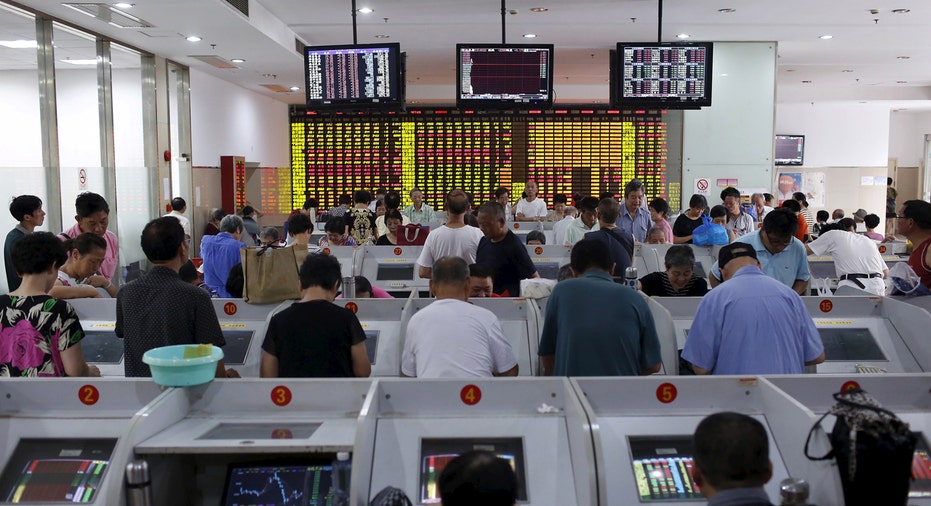Chinese Stocks Breach Dec 2014 Closing Low

Chinese shares tumbled again on Friday, with the Shanghai index closing lower than at any time since December 2014, leaving most who put their faith in Beijing's measures to end last summer's crash nursing losses.
On the currency markets the yuan weakened sharply offshore, opening up a gap of more than 1 percent with the steady onshore market, despite central bank efforts earlier in the week to squeeze out speculators.
Onshore the yuan was 0.1 percent up on the week, but it is nearly 1.4 percent weaker against the dollar for the year so far and has lost nearly 5 percent since August.
Both the major stock indexes shed more than 3 percent, raising questions about Beijing's ability to stop a sell-off that has now reached 18 percent since the beginning of the year.
"The 'National Team' wants to stem the fall, but it just cannot stop the stampede, as investors are selling in panic," said Shen Weizheng, fund manager at Shanghai-based Ivy Capital.
The turbulent start to 2016, with currency and stock markets tumbling, has stoked concerns that Beijing's policymakers were in danger of fumbling as the country headed toward its slowest growth in 25 years.
"The key issue is that people don't have confidence in the economy, and the yuan remains under pressure to depreciate. Beijing can no longer pump liquidity into the economy as it would cause further falls in yuan's value," said Shen, adding that the fall would lead to more margin calls for those who borrowed to buy shares and a loss in value of collateralized stocks, which would trigger further selling.
Upbeat economic figures earlier in the week on trade and investment had tempered some of the fears about the slowdown in the world's second-largest economy, but Friday brought news that fresh lending by Chinese banks was weaker than expected in December and well down on the previous month.
China's economic growth is expected to slow to 6.5 percent in 2016 from a forecast 6.9 percent in 2015, prompting the government to ease policy further, a Reuters poll showed.
OFFSHORE YUAN SLIPS
After a calmer few days on the currency market, signs of stress began to re-emerge.
The People's Bank of China (PBOC) has fixed the midpoint for the yuan broadly steady for more than a week, signaling a determination to hold the line against expectations of sustained depreciation.
But dealers said the yuan would resume its decline if the central bank loosened its grip, and more than 30 major market players in Europe and the United States told Reuters they would not rule out a further 15 percent depreciation this year.
The bank set the midpoint for the tightly managed currency at 6.5637 per dollar on Friday, weaker than the previous fix of 6.5616 but 253 pips stronger than Thursday's closing quote 6.5890.
The spot market was changing hands at 6.5871 in afternoon trade, 19 pips firmer than the close. The spot rate is allowed to deviate 2 percent either side of the daily fix.
"The key for the spot rate's move is the central bank's attitude," said a dealer at an Asian bank in Shanghai.
"Once it stops holding the midpoint, the spot rate is likely to drop back and break through 6.6 in the short-term."
Offshore the yuan was jolted weaker, and about 1.1 percent below the onshore spot at 6.6617 per dollar, buffeted by strong dollar demand, and persistent expectations that the yuan would weaken going forward, traders said.
Offshore yuan liquidity had been squeezed earlier in the week as a result of state-backed banks buying, at the central bank's behest, making it prohibitively expensive to bet against the yuan.
The International Monetary Fund called on China to be clearer about its exchange rate policy.
"More clarity and communication around the exchange rate regime would be useful," IMF spokesman Gerry Rice told a regular news briefing in Washington on Thursday.
STOCKS IN RED
Other Asian share markets were briefly buoyed on Friday when oil prices rallied overnight, but they gave up their gains when oil resumed its collapse, reigniting fears about the health of the global economy.
China's main indexes opened lower and extended their fall throughout the day. The Shanghai Composite Index ended down 3.5 percent at 2902.22, while the CSI300 index dropped 3.2 percent at 3118.73.
China's major share indexes have lost 16-18 percent so far in 2016, and although the close is the lowest since December 2014, the 2015 intraday lows chalked up in August, when the market lost more than 40 percent in a summer crash, have still to be breached.
The August low might have been lower still, had regulators not wheeled out a raft of measures to support the market, and some think Beijing would do the same again to try to stop the indexes breaching those levels.
"The crowd is still keen to pounce on Shanghai's great fall, and as such the final stage of market revulsion is yet to come," said Hong Hao, managing director at BOCOM International.
(Reporting by Nathaniel Taplin and Samuel Shen; Writing by Will Waterman; Editing by Simon Cameron-Moore)



















